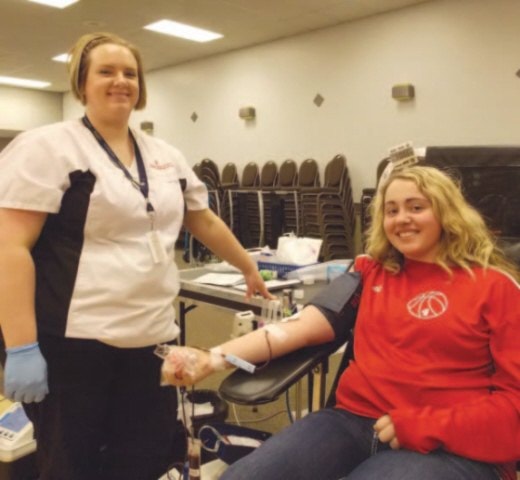The Stettler Community Centre was a bustling place Monday night as more than 100 people gathered to donate blood during Canadian Blood Services’ monthly visit to town.
“We receive excellent support from the Hutterite communities in the area,” said Marta Boulton, the blood drive supervisor. “We always have high numbers here in Stettler.”
To donate blood, people must be 17 years old and pass a screening interview with a nurse and some onsite testing to ensure blood levels are high enough to safely donate.
Factors that would disqualify someone intending to donate blood would be travel to a destination with high malaria rates, tattoos or piercings within six months, flu shots or dental work in the previous three days, and blood-transmissible diseases like hepatitis or HIV. People must wait a year after receiving a blood transfusion before donating blood.
Amberly Hepp, 17, of Castor made the trip to Stettler to make her second blood donation.
“Just the thought of helping someone else (makes me do this),” Hepp said. “It could be my family member in that same position.”
The teenager was calm as blood flowed from the needle in her arm into the collection bag, which holds about four cups of blood. When the needle is going in, however, was another story.
“I play games on my phone so I don’t feel it (needle) go in,” she said with a laugh.
After the blood is collected, it is taken to be tested for blood-borne illnesses and diseases and then is separated into its parts — plasma, platelets and white blood cells, and red blood cells. Red blood cells make up just less than half of the blood taken from the body and plasma makes up almost all the rest. Less than one per cent of blood is platelets and white blood cells.
One unit of red blood cells, given during a transfusion, is equal to the amount of red blood cells collected from one person during a transfusion. A person going into surgery after a traumatic incident, such as a vehicle collision, can require several units of blood. People who have low blood counts, are undergoing treatment for cancer or other diseases, or do not produce platelets are only some of the people who rely on Canadian Blood Services’ efforts to collect blood.
Hepp brought friends with her to her first donation last November. People can only donate whole blood every three months — the time period can be shorter for people who donate specific blood components like plasma — and Hepp headed in to make her second donation as soon as her three months had passed. “It’s important,” she said.
Boulton said it takes about an hour for donors to move from the registration process to heading out the door. People who want to donate should make sure they eat healthily, with plenty of fluids, the day of the donation and the day before. Phone 1-800-2-DONATE for information.
